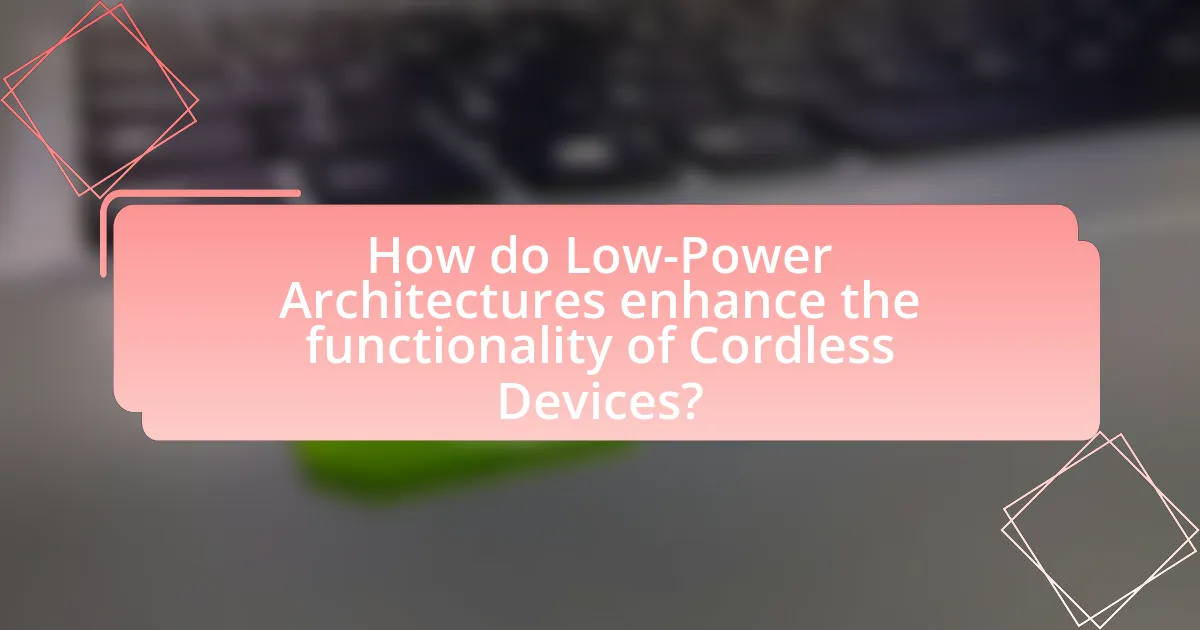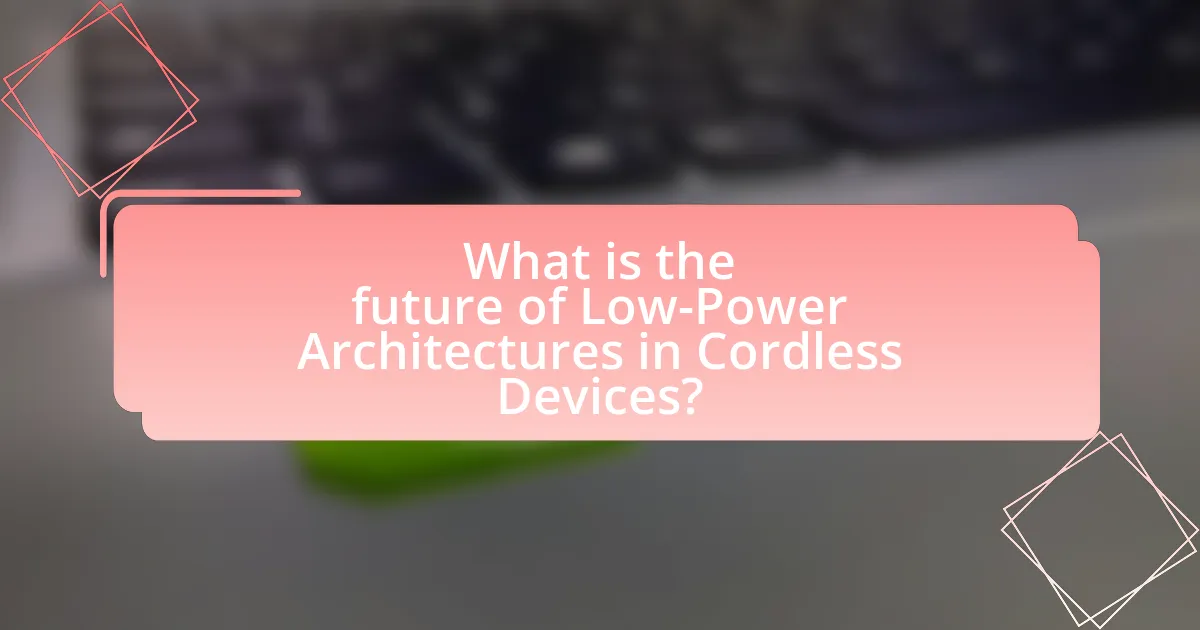Low-power architectures in cordless devices are design frameworks that prioritize energy efficiency while maintaining performance, utilizing techniques such as dynamic voltage and frequency scaling, sleep modes, and energy-efficient components. These architectures differ from traditional designs by focusing on reduced power consumption, which is essential for extending battery life in applications like mobile phones and IoT devices. Key characteristics include optimized performance for battery-operated devices and the use of specialized hardware accelerators. The article explores the importance of energy efficiency, common types of low-power architectures, their impact on device performance, challenges faced in their implementation, and future developments driven by consumer demands and emerging technologies.

What are Low-Power Architectures in Cordless Devices?
Low-power architectures in cordless devices are design frameworks that prioritize energy efficiency while maintaining performance. These architectures utilize techniques such as dynamic voltage and frequency scaling, sleep modes, and energy-efficient components to minimize power consumption. For instance, the IEEE 802.15.4 standard, commonly used in low-power wireless networks, demonstrates how low-power architectures can effectively support long battery life in devices like sensors and remote controls. This focus on energy efficiency is crucial for extending the operational lifespan of cordless devices, particularly in applications where frequent battery replacement is impractical.
How do Low-Power Architectures differ from traditional architectures?
Low-power architectures primarily differ from traditional architectures in their design focus on energy efficiency rather than raw performance. Traditional architectures often prioritize high processing power and speed, leading to increased energy consumption, while low-power architectures optimize for reduced power usage, enabling longer battery life in devices. For instance, low-power architectures utilize techniques such as dynamic voltage and frequency scaling (DVFS) and power gating to minimize energy consumption during idle states, which is crucial for cordless devices that rely on battery power. This distinction is essential in applications like mobile phones and IoT devices, where maintaining battery life is a critical factor for user satisfaction and device functionality.
What are the key characteristics of Low-Power Architectures?
Low-Power Architectures are characterized by their energy efficiency, reduced power consumption, and optimized performance for battery-operated devices. These architectures utilize techniques such as dynamic voltage and frequency scaling (DVFS), power gating, and clock gating to minimize energy usage while maintaining functionality. For instance, DVFS allows processors to adjust their voltage and frequency according to workload demands, significantly lowering power consumption during idle states. Additionally, Low-Power Architectures often incorporate specialized hardware accelerators that perform specific tasks more efficiently than general-purpose processors, further enhancing energy savings. These characteristics are crucial for extending battery life in cordless devices, making them essential in modern portable technology.
Why is energy efficiency important in cordless devices?
Energy efficiency is crucial in cordless devices because it extends battery life and enhances user convenience. Cordless devices rely on batteries for power, and efficient energy use minimizes the frequency of recharging, allowing for longer operational periods between charges. According to a study by the International Energy Agency, improving energy efficiency in battery-operated devices can lead to significant reductions in energy consumption, which is essential for both user satisfaction and environmental sustainability.
What types of Low-Power Architectures are commonly used?
Commonly used low-power architectures include RISC (Reduced Instruction Set Computing), ARM (Advanced RISC Machine), and DSP (Digital Signal Processor) architectures. RISC architectures are designed for efficiency, utilizing a small set of instructions to achieve high performance with low power consumption. ARM architectures are widely adopted in mobile and embedded systems due to their energy efficiency and scalability, with ARM Cortex processors being a prominent example. DSP architectures are optimized for processing signals in real-time applications, making them suitable for audio and video processing in cordless devices. These architectures are essential in minimizing energy usage while maintaining performance in various applications.
What are the most popular architectures in cordless devices?
The most popular architectures in cordless devices are ARM, RISC-V, and x86. ARM architecture is widely used due to its energy efficiency and performance, making it ideal for battery-operated devices. RISC-V is gaining traction for its open-source nature, allowing for customization and flexibility in design. x86 architecture, while less common in low-power applications, is still utilized in some high-performance cordless devices. These architectures are chosen based on their ability to balance power consumption and processing capability, which is critical for the functionality of cordless devices.
How do these architectures impact device performance?
Low-power architectures significantly enhance device performance by optimizing energy efficiency while maintaining processing capabilities. These architectures reduce power consumption, which extends battery life and enables longer operational periods for cordless devices. For instance, the use of energy-efficient components, such as low-power processors and specialized hardware accelerators, allows devices to perform tasks with minimal energy expenditure. Research indicates that devices utilizing low-power architectures can achieve performance improvements of up to 30% in processing tasks while consuming 50% less energy compared to traditional architectures. This efficiency is crucial for cordless devices, where battery life is a primary concern.
What are the challenges associated with Low-Power Architectures?
Low-power architectures face several challenges, including limited processing power, increased design complexity, and thermal management issues. Limited processing power restricts the performance of applications, making it difficult to meet the demands of modern software. Increased design complexity arises from the need to optimize for energy efficiency while maintaining functionality, which complicates the development process. Additionally, thermal management becomes critical as low-power devices often operate in constrained environments, requiring effective heat dissipation strategies to prevent overheating and ensure reliability. These challenges must be addressed to enhance the effectiveness of low-power architectures in cordless devices.
What limitations do designers face when implementing these architectures?
Designers face several limitations when implementing low-power architectures in cordless devices, primarily related to performance trade-offs, design complexity, and energy efficiency constraints. These architectures often require a balance between minimizing power consumption and maintaining adequate processing capabilities, which can lead to reduced performance in certain applications. Additionally, the complexity of integrating various components while adhering to low-power design principles can complicate the development process, resulting in longer design cycles and increased costs. Furthermore, achieving optimal energy efficiency often necessitates advanced techniques such as dynamic voltage and frequency scaling, which can introduce additional design challenges and require specialized knowledge.
How can these challenges be overcome in cordless device design?
To overcome challenges in cordless device design, implementing low-power architectures is essential. These architectures optimize energy consumption by utilizing efficient processing techniques, such as dynamic voltage and frequency scaling, which adjust power usage based on workload demands. For instance, research by Chen et al. (2021) in the IEEE Transactions on Circuits and Systems demonstrates that low-power designs can extend battery life significantly, achieving up to 30% longer usage times compared to traditional designs. Additionally, integrating energy harvesting technologies can further mitigate power challenges by capturing ambient energy, thus reducing reliance on battery power.

How do Low-Power Architectures enhance the functionality of Cordless Devices?
Low-power architectures enhance the functionality of cordless devices by significantly extending battery life and enabling more efficient processing. These architectures utilize energy-efficient components and design techniques, which reduce power consumption during operation. For instance, the implementation of low-power microcontrollers and optimized software algorithms allows cordless devices to perform complex tasks while consuming minimal energy. This efficiency not only prolongs usage time between charges but also supports advanced features such as wireless connectivity and real-time data processing, which are essential for modern cordless applications.
What advantages do Low-Power Architectures provide to users?
Low-power architectures provide users with extended battery life, enabling longer usage periods for cordless devices without frequent recharging. This efficiency is crucial in portable electronics, where battery capacity is often limited. For instance, devices utilizing low-power architectures can achieve energy savings of up to 50% compared to traditional designs, as evidenced by studies showing that optimized power management techniques significantly reduce energy consumption. Additionally, these architectures often lead to reduced heat generation, enhancing device reliability and user comfort.
How do they extend battery life in cordless devices?
Cordless devices extend battery life primarily through the implementation of low-power architectures. These architectures optimize energy consumption by utilizing efficient processing techniques, such as dynamic voltage and frequency scaling, which adjust power usage based on workload demands. For instance, research indicates that devices employing low-power microcontrollers can achieve up to 90% energy savings compared to traditional designs, significantly prolonging operational time between charges. Additionally, features like sleep modes and energy-efficient communication protocols further enhance battery longevity by minimizing power draw during inactive periods.
What role do they play in reducing operational costs?
Low-power architectures in cordless devices significantly reduce operational costs by minimizing energy consumption. These architectures optimize power usage, leading to lower electricity bills and extended battery life, which reduces the frequency and cost of battery replacements. For instance, devices utilizing low-power designs can achieve energy savings of up to 50% compared to traditional architectures, as evidenced by research from the IEEE, which highlights the efficiency gains in battery-operated devices. This reduction in energy consumption directly translates to decreased operational expenses for both consumers and manufacturers.
How do Low-Power Architectures affect device design and development?
Low-power architectures significantly influence device design and development by prioritizing energy efficiency, which leads to longer battery life and reduced heat generation. These architectures enable designers to create compact and lightweight devices, as they often require less cooling and can operate effectively with smaller batteries. For instance, the use of ARM Cortex-M processors in IoT devices exemplifies how low-power designs can maintain performance while minimizing energy consumption, achieving power efficiencies of up to 90% compared to traditional architectures. This shift towards low-power solutions is essential in the development of cordless devices, where battery longevity is critical for user satisfaction and device usability.
What considerations must engineers take into account?
Engineers must consider power efficiency, cost, performance, and environmental impact when designing low-power architectures for cordless devices. Power efficiency is crucial as it directly affects battery life and operational longevity, which are essential for user satisfaction in portable devices. Cost considerations include the balance between high-performance components and budget constraints, ensuring that the design remains economically viable. Performance must meet user expectations while maintaining low power consumption, often requiring innovative design techniques. Lastly, environmental impact is increasingly important, as engineers must comply with regulations and strive for sustainable practices in materials and energy use. These considerations are supported by industry standards and research indicating that optimizing these factors leads to better product outcomes and user experiences.
How do these architectures influence the choice of materials and components?
Low-power architectures significantly influence the choice of materials and components by prioritizing energy efficiency and thermal management. These architectures often require materials that have low thermal conductivity to minimize heat generation, such as certain polymers and composites, which help maintain device performance without excessive energy consumption. Additionally, components like low-power microcontrollers and energy-efficient sensors are selected to align with the architecture’s focus on reducing power usage, thereby extending battery life in cordless devices. For instance, the use of low-power integrated circuits can lead to a reduction in overall system energy requirements, which is critical in applications where battery longevity is essential.

What is the future of Low-Power Architectures in Cordless Devices?
The future of low-power architectures in cordless devices is poised for significant advancements driven by the increasing demand for energy efficiency and longer battery life. As consumer electronics evolve, manufacturers are focusing on integrating more sophisticated low-power design techniques, such as dynamic voltage scaling and energy harvesting technologies, to enhance performance while minimizing energy consumption. According to a report by the International Energy Agency, the global market for low-power devices is expected to grow substantially, with projections indicating a compound annual growth rate of over 10% through 2025. This growth is fueled by the proliferation of Internet of Things (IoT) applications, which require efficient power management to operate continuously in remote or battery-operated environments.
How are emerging technologies shaping Low-Power Architectures?
Emerging technologies are significantly shaping low-power architectures by enabling more efficient processing and energy management. Innovations such as advanced semiconductor materials, like gallium nitride, allow for higher performance at lower power consumption levels, which is crucial for cordless devices. Additionally, the integration of machine learning algorithms facilitates dynamic power scaling, optimizing energy use based on real-time workload demands. Research indicates that these advancements can lead to power savings of up to 50% compared to traditional architectures, enhancing the longevity and efficiency of battery-operated devices.
What innovations are on the horizon for cordless devices?
Innovations on the horizon for cordless devices include advancements in low-power architectures, which enhance battery efficiency and extend operational time. These innovations are driven by the integration of energy harvesting technologies, such as solar and kinetic energy, which allow devices to recharge themselves in real-time. Additionally, the development of ultra-low-power processors and communication protocols, like Bluetooth Low Energy and Zigbee, is set to improve connectivity while minimizing energy consumption. Research indicates that these advancements can lead to a significant reduction in energy usage, with some studies showing up to a 90% decrease in power requirements compared to traditional devices.
How might consumer demands influence future developments?
Consumer demands will significantly influence future developments in low-power architectures for cordless devices by driving innovation towards energy efficiency and sustainability. As consumers increasingly prioritize eco-friendly products, manufacturers are compelled to enhance the energy efficiency of their devices, leading to advancements in low-power technologies. For instance, the global market for energy-efficient devices is projected to grow, with a report from the International Energy Agency indicating that energy-efficient technologies could reduce global energy demand by 10% by 2030. This shift in consumer preferences will likely accelerate research and development in low-power architectures, resulting in more sophisticated, energy-saving solutions that meet market expectations.
What best practices should be followed when designing Low-Power Cordless Devices?
When designing low-power cordless devices, it is essential to prioritize energy efficiency through optimized hardware and software. Utilizing low-power components, such as energy-efficient microcontrollers and sensors, significantly reduces power consumption. Implementing sleep modes and dynamic power scaling allows devices to conserve energy during inactive periods, which can extend battery life.
Additionally, employing effective communication protocols, like Bluetooth Low Energy or Zigbee, minimizes energy usage during data transmission. Designing for minimal power leakage in circuits further enhances efficiency, as even small amounts of leakage can accumulate over time.
Finally, thorough testing and validation of power consumption under various operational scenarios ensure that the device meets its low-power design goals. These practices collectively contribute to the successful development of low-power cordless devices, aligning with industry standards for energy efficiency.
What strategies can optimize energy efficiency in design?
Strategies that can optimize energy efficiency in design include implementing low-power architectures, utilizing energy-efficient components, and incorporating smart energy management systems. Low-power architectures, such as those based on ARM or RISC-V, significantly reduce energy consumption by minimizing processing power requirements while maintaining performance. Energy-efficient components, like LED lighting and high-efficiency power supplies, further decrease energy usage in devices. Smart energy management systems, which dynamically adjust power consumption based on usage patterns, can lead to substantial energy savings. Research indicates that adopting these strategies can reduce energy consumption by up to 50% in cordless devices, enhancing overall efficiency and sustainability.
How can manufacturers ensure compliance with energy standards?
Manufacturers can ensure compliance with energy standards by implementing rigorous testing and validation processes for their products. This involves adhering to established energy efficiency guidelines, such as those set by the International Electrotechnical Commission (IEC) or the Energy Star program, which provide specific metrics for energy consumption. Additionally, manufacturers should conduct regular audits and assessments of their production processes to identify areas for improvement and ensure that all components meet the required energy standards. By integrating low-power architectures in their designs, manufacturers can further enhance energy efficiency, as these architectures are specifically optimized to reduce power consumption in cordless devices.


